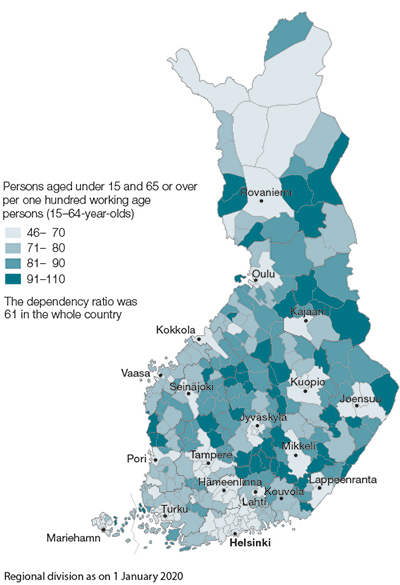News 11 Jun 2020
Finland in Figures 2020 is about us
Statistics Finland’s new Finland in Figures 2020 publication summarises key statistical figures about Finland and Finns into a pocket-size information package. The publication contains information on the population, economy, society and environment as statistical figures and graphs.
Extracts from the publication:
- At the end of 2019, the total population of Finland was 5,525,292 persons, of whom 2,797,030 were women and 2,728,262 men.
- In 2019, the biggest 5-year age group was those aged 55 to 59, totalling 368,871 persons, or 6.7 per cent of the whole population. The number of women was highest among those aged 70 to 74 and that of men among persons aged 35 to 39.
- Last year, the share of those living alone was 45 per cent of all household-dwelling units. In 2019, the number of persons aged 90 or over living alone was 30,107, up by 5.4 per cent from the previous year.
- At the end of 2019, there were 1.5 million families in Finland. In all, 38 per cent of them were families with children aged 0 to 17, totalling 558,302. Most of families with children had one child, 43 per cent. A total of 1,028,030 children were living in families with children, their number falling by nearly 10,000 from the previous year.
- In 2019, the number of working-age persons aged 15 to 64 was 123,576 lower than in 2010. The share of the working-age population has fallen from 66 to 62 per cent.
Demographic dependency ratio by municipality 2019

- The demographic dependency ratio in the whole country was 61 in 2019. The figure describes the ratio of persons aged under 15 and over 65 to the working-age population. This ratio is multiplied by one hundred. There are big differences between municipalities. The dependency ratio was highest in Kaskinen (110) and Kuhmoinen (109) and lowest in Helsinki (46), Tampere (48) and Vantaa (49).
- In forty years, the shares of housing and food have changed most in household consumption expenditure. The share of housing and energy in households’ consumption expenditure was 29 per cent in 2018 (preliminary data), having been 19 per cent in 1980. Twelve per cent of households' expenditure was spent on food and non-alcoholic beverages in 2018, while the share was 21 per cent in 1980.
- Finland's main trade partners in 2019 were Germany, Sweden and Russia. According to preliminary data, these three countries accounted for 41 per cent of Finland’s total imports and for 31per cent of exports. The value of the chemical industry's products was highest both in imports and exports.
- Finland's tax ratio was 42.7 per cent, which was the fifth highest in OECD countries according to preliminary data for 2018. The share of tax revenue of gross domestic product was higher in France, Denmark, Belgium and Sweden. The tax rates of Turkey, the United States and Ireland were lowest in the comparison countries, under 25 per cent of GDP. The comparison included 20 OECD countries.
In addition to Statistics Finland’s data, Finland in Figures contains data produced by the Finnish Institute for Health and Welfare, the Natural Resources Institute Finland, Finnish Customs, the Social Insurance Institution, the Finnish Centre for Pensions and the Finnish Immigration Service.
The publications are available in printed form in three languages: Suomi lukuina 2020, Finland i siffror 2020 and Finland in Figures 2020. The publications are available on Statistics Finland’s website as a PDF publication and as a web service.
The publications can be ordered from PunaMusta Oy’s online store and customer service tel. +358 10 2308 365.
Further information: Planner Sirkku Hiltunen tel. +358 29 551 6373
